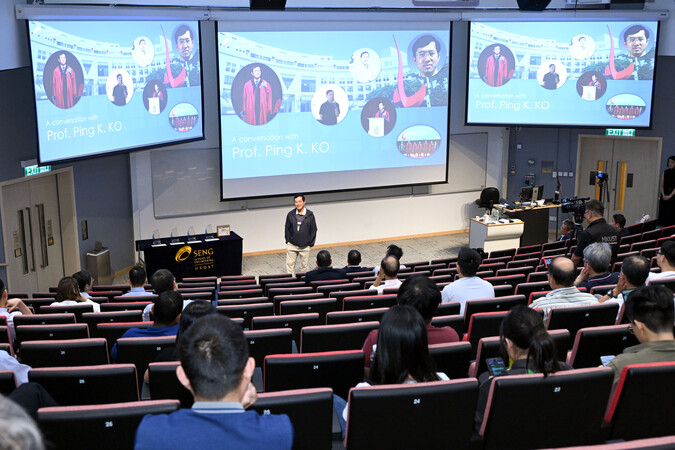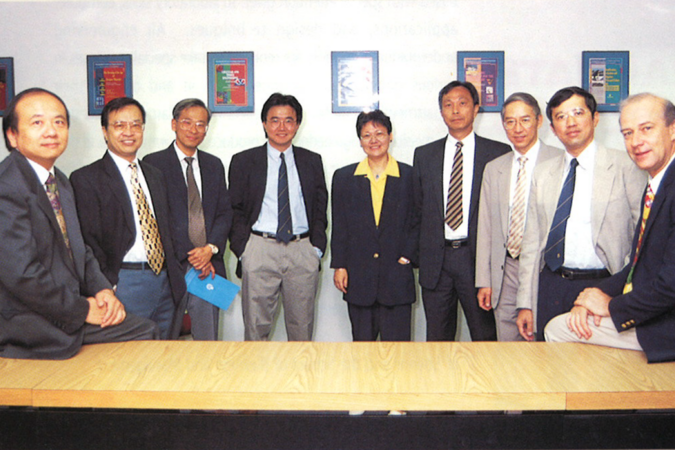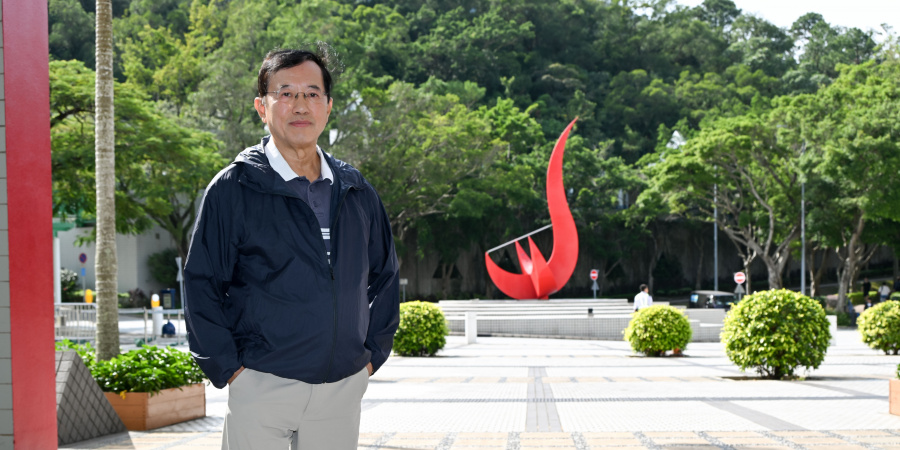Igniting Innovation and Entrepreneurship
Academic-entrepreneur Prof. KO Ping-Keung came to HKUST in 1993 as Visiting Professor in the Department of Electronic and Computer Engineering after working at the University of California, Berkeley, as Director of the Microfabrication Laboratory from 1984-1993, and Vice-Chairman of the Department of Electrical Engineering and Computer Sciences from 1991-1993. He served as Dean of the HKUST School of Engineering from 1995-2000 and in 2002 received the prestigious IEEE Solid-State Circuits Award. He has since become an innovator and angel investor in China’s chip industry and is a Professor Emeritus at HKUST. In 2024, Prof. Ko was awarded a HKUST Honorary Fellowship in recognition of his long-standing service and commitment to the University’s development.
When did you first start to build ties with HKUST?
I was one of a few people that the late Prof. Chia-Wei WOO contacted when he was appointed Founding President of Hong Kong’s new university and was starting to plan. My involvement started very early on, in 1987 or 1988, so way before the University opened in 1991. I was at Berkeley and Chia-Wei was in the process of moving from San Francisco to Hong Kong. I did some writing on initial plans for the Electrical and Electronic Engineering Department [now Electronic and Computer Engineering] and a little for the School of Engineering (SENG). I also helped recruit some of the early faculty, including Prof. Philip CHAN, who later became Dean.
Why were you interested in being involved?
I felt a burden of history. Before I graduated from the University of Hong Kong in 1973-74 and went to Berkeley to study physics – electrical engineering for chip design – I already had a plan, which was to learn everything about chips and then come back to China to start my career in chips. Going to HKUST fitted in the middle of this. It just so happened there was an opportunity to start a new university which had an agenda I liked very much – teaching, research, and also technology transfer.
For me, making technology transfer one of the pillars was the key component that made HKUST different from any other university in Hong Kong. I fully embraced this as a major parameter as it was what I had been doing at Berkeley and I believed China needed a modern, state-of-the-art university to move forward or lead the country’s development. If somebody had offered me a position to go to the University of Hong Kong or Chinese University of Hong Kong, I wouldn’t have taken it because I didn’t believe that at these two older universities I could do what I wanted, which was to move higher education in Hong Kong toward research and innovation as well as teaching. At HKUST, there would be a completely new setting, people, and a lot of resources, and I thought we might be able to add a new piece into the higher education environment jigsaw.
How did you become Dean?
When I joined HKUST, serving as Dean was not on the agenda because it is an administrative role, which didn’t really interest me. I went to HKUST because I saw it as a real opportunity to be involved in starting a university and developing teaching, research, and technology transfer infrastructure before leaving for industry. But when the Founding Dean left, engineering faculty members came to ask me if I would take on the endeavor to lead the School.
Why did you agree?
I am a Hong Kong native so I knew how things worked at local universities. And I was a member of the University Grants Committee (UGC).* I had joined the UGC when I was at Berkeley, not because of HKUST. I had my own base in Hong Kong. It meant I could argue the case with the Founding President to build the School of Engineering in a way that the engineering faculty needed and wanted.
* Prof. Ko was a member of the University Grants Committee from 1988-2000 and Chairman of the Research Grants Council from 1994-1999.
How did you take the School forward?
By hiring excellent faculty for all the departments, setting and achieving good teaching standards – I spent quite a bit of time making sure that every faculty member understood they earned research rights through quality teaching – and developing a plan as to how to make good use of the financial resources available to the School of Engineering.
There were quite a lot of resources at that time. One pot of money was the annual budget that comes from the University out of its UGC allocation. Each School had to submit a plan to get the resources. It was a tug-of-war process but really depended on how good your plan was and how good you were. Although there were some politics, President Woo’s first principle was that priority goes to the University’s development. So, he was a very fair person, but you had to convince him.
There was also a pot of equipment money from the Legislative Council that I helped distribute. We developed a number of important labs in the School of Engineering. Major central University facilities included the Microelectronics Fabrication Facility [now Nanosystem Fabrication Facility] and Geotechnical Centrifuge Facility. Each department also had specialized labs that individual faculty built. For example, in the Department of Electrical and Electronic Engineering, there was a device research lab, microelectronics, and a sensor component. Prof. LI Zexiang’s Automation Technology Center (ATC) was also established. I worked closely with Prof. Li throughout the years to start numerous companies through ATC, including consumer drone companies such as DJI.
What was your goal in allocating such funds?
When I distributed resources I placed a strong emphasis on the research labs being for younger faculty. The senior faculty were just there to help the young faculty build the University. I have been very happy to see these early career faculty grow to become major researchers. Many of my subordinates back then have gone on to become a vice-chancellor, vice-president, or to take up other senior positions in universities in Hong Kong. We do have a reputation for nurturing people; and I’m proud to see that, some 20 years after I left, I still have very good relations with these younger-now-senior members.
How about your aspirations for technology transfer?
When I took over as Dean, entrepreneurship and how to facilitate knowledge transfer were components that weren’t yet in place at the University. At the time, there were all these extremes in how Hong Kong and Mainland universities approached entrepreneurship – some relaxed and others highly restrictive. However, US universities such as Berkeley and Stanford were way ahead in terms of defining boundaries for staff and institutions. So I wrote a Hong Kong version of the Silicon Valley model for HKUST with then Associate Vice-President for Research and Development Prof. Tony EASTHAM and this became the first version of the HKUST Entrepreneurship Program.
Did you have personal experience of entrepreneurship at that time?
Yes, I had set up a chip design software company with a student while I was at Berkeley. The start-up focused on computer-aided design. This meant entrepreneurship wasn’t new to me when I came back to Hong Kong. Later, in 2004, we sold the business to a famous company called Cadence, which gave me my first bucket of gold to become an angel investor.
What was the impact of the HKUST Entrepreneurship Program?
The program provided something new for local universities: entrepreneurship with well-defined legal boundaries. But that didn’t mean all the faculty immediately started a company because very few academics had the skill or mentality to transfer knowledge in this way. Even in the School of Engineering, not to mention Science. So it has taken a while because someone needed to demonstrate how it could be done. I always say that hi-tech entrepreneurship and hi-tech enterprise really took off in China with DJI [in 2006] because you need an example.
Right now, I see that HKUST entrepreneurship has grown from a virtual to a real environment. Previously, it was a virtual environment because ‘Hey, you can do it’ but how can you do it?’ Once someone led the way, then others said: ‘Wow, that’s good. I can contribute to technology, to China, and to myself because I can earn money.’ When people see a return, they will jump in. Now, there are a lot of real companies. HKUST faculty and students have probably started more companies than any other university in China in the past 20 years or so.

What social activities do you remember taking part in as Dean?
From February to May or June each year, the bay next to the HKUST campus is filled with squid, and there were lots of wonderful boat trips at night where faculty and students went fishing for squid and then cooked them. You don’t need any bait to fish for squid. You hang lamps around the boat. Then the squid gather around and you just hook them up. I took out the Engineering Students’ Union, a group of Mainland students, and faculty members on boat trips. Most enjoyable and memorable.
Why did you leave SENG?
President Woo was a visionary in how he wanted to build the University and I knew I could help him. By 2000, I also knew I had pretty much finished my job. By then, I felt the University had practically everything in place for engineering: good faculty focused on quality research and teaching, major research facilities, and the Entrepreneurship Program. To me, the fun part of early development was over. Moreover, my original goal was to help China build a silicon chip industry and I thought it was time to go back to this. So I decided to leave.
What would you say to people today at the School of Engineering?
I think HKUST is in a great position to do more, especially now that the geopolitical environment is making direct interaction between Chinese and US universities difficult and HKUST has established a reputation for successful promotion of entrepreneurship. One advantage, especially in engineering, is the use of English at HKUST. This means that students from the Mainland or internationally have to be proficient in English communication when they graduate from HKUST. In engineering schools in the Mainland, they learn very little English or don’t care that much about it. But it is very important if you want to go international as an entrepreneur; and you have to go international.
What do you see in your own future?
We dreamers of HKUST’s founding generation provided the pathway and platform for the current faculty, staff, and students. But I still have a dream that entrepreneurship should start even earlier so that students already have ideas in place when they come to university. Stand-out innovators such as Steve JOBS and Elon MUSK may be a very, very small percentage of their whole age group but they change history. Yet Asia in general lacks the environment to foster such people as we want our kids to be too obedient and live too much of a structured life. I think the University should start a summer school or technology boot camp, then invite our entrepreneurs and companies to talk, demonstrate their products, and inspire parents and children. I want immersion, that families using these companies’ products will be able to relate closely to what lies behind the product in order to encourage the next generation to generate their own dreams. That’s my job for the next 20 years!



